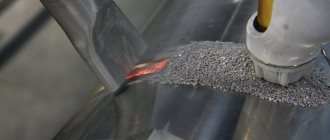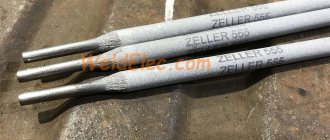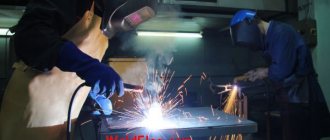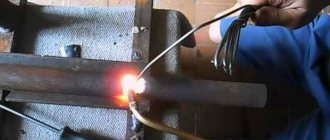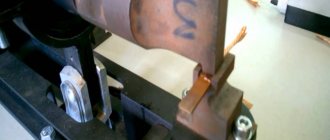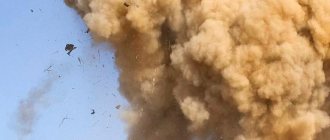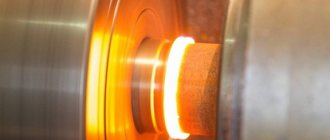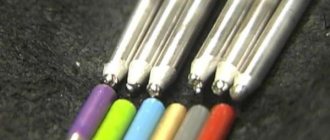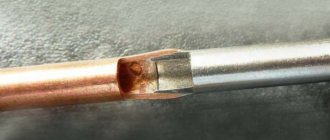Alloying of steels is carried out to obtain special properties that allow the material to be used in various extreme conditions for conventional steels.
Welding alloy steels has its own specifics, because it is necessary not only to obtain the necessary physical and mechanical reliability of the weld joint, but also to preserve the characteristics of the base alloy in it.
Welding mode
Joining high-alloy steels and alloys requires the correct setting of the welding mode. The quality of the finished seam largely depends on this. We recommend setting a low welding current and creating narrow seams. This can be achieved using welding wire or electrodes with a diameter of 2-3 millimeters. We also recommend reducing the electrode extension by 2 times more than usual. This will make your welding easier. After all, welding high-alloy steel is largely difficult due to high electrical resistance and reduced electrical conductivity. And by reducing the electrode overhang, you eliminate these shortcomings.
Selecting Electrodes
When welding high-alloy steels, it is recommended to use electrodes with a basic coating, which should contain protective and alloying elements. The rod itself must also be highly alloyed. Electrodes and metal of similar composition will work in conjunction with each other, forming a high-quality seam.
If you need to weld high-alloy austenitic steel, we recommend using TsT-15 electrodes. They are excellent for steel grade E-08Х19Н10Г2Б, since they contain up to 5% ferrite phase. And this is very good.
High alloy steels
High-alloy steels are used in various fields of industry and economy. Most often they are used in the oil and chemical industries and energy. Such steels are widely used in structures operating in aggressive environments and large temperature differences.
Based on their properties, there are two main types of high-alloy steels:
- corrosion resistant;
- heat-resistant , or heat-resistant.
Along with the content of additives, high-alloy steels are also classified by the type of their internal structure. Their structures are varied and depend on the content of the main elements. In this case, steels are distinguished:
- martensitic;
- ferritic;
- austenitic.
There are also high-alloy steels with a mixed structure. For example, ferrite-austenitic.
The most common type of high-alloy steel is steel with austenite structure. The main components of such steels are nickel (up to 8%) and chromium (≥18%). By changing the composition of other additives, high-alloy steels with the required properties are obtained. At the same time, chromium provides heat resistance and corrosion resistance, and nickel makes steel more ductile and increases heat resistance.
In addition, to increase heat resistance, tungsten and vanadium are introduced into the composition, and for corrosion resistance (stainless steel), titanium and molybdenum are introduced into the steel composition.
Selection of fluxes
Welding of alloy and carbon metals can also be performed using flux. But here, as in the case of electrodes, you need to use special fluxes and correctly combine them with the welding wire. The fluxes themselves must be fluoride, and the wire must be highly alloyed, like the metal. We recommend ANF-5 flux; it copes well with its protective function and improves the quality of the seam when welding high-alloy steel.
Thanks to the use of ANF-5 flux, the seam will not be susceptible to the formation of pores, cracks and other weld defects. For this reason, such a flux is often used not only in home welding, but also in large-scale welding production. By the way, you can use other oxide-based fluxes. Their properties will not differ much from ANF-5.
As an alternative, we suggest using AN-26 flux. It is also made on the basis of oxides and contains little silicon, so the seam will be formed efficiently and quickly. But please note that there is a high probability of strong oxidation of titanium and aluminum, and even a well-chosen wire will not help; silicon will actively transfer into the seam. Because of this, hot cracks and pores may likely appear, and in general the seam will be fragile. So use this flux on less critical objects.
Also pay attention to flux brand AN-292. It is made on the basis of highly stable oxides and has proven itself in operation. But you need to monitor the amount of hydrogen; if there is too much of it, the seam may turn out to be porous after welding is completed.
Shielding Gas Selection
Shielding gas can also be used. Helium, argon and carbon dioxide are often used. And in some cases, a mixture of these gases is used. The technology for welding high-alloy steels using shielding gases has proven itself well. But in addition to gas, you will need to purchase more electrodes. We recommend non-consumable tungsten. Welding must be carried out using direct current with reverse polarity. If the steel contains a lot of aluminum, then you can cook with direct polarity to quickly destroy the oxide film that interferes with the formation of the weld.
Sometimes when welding austenitic steels using shielding gases, unstable arc combustion is observed. To correct this problem, you can mix argon and oxygen or argon and carbon dioxide. This way the arc will burn stably and the seam will not be porous.
As for carbon dioxide, it has many positive properties. Thanks to it, the likelihood of pore formation is minimal. And in combination with argon, carbon dioxide shows the best results. So if you have the opportunity to use a mixture of these two gases, then be sure to try it in your practice.
But there is also a drawback. When welding in carbon dioxide, the metal spatters much more, and this worsens the anti-corrosion properties of steel. And the technology of welding alloy steels using carbon dioxide is associated with another problem - the active formation of an oxide film on the metal surface, which is difficult to remove. And if with single-layer welding this drawback is not so significant, then with multi-layer welding the oxide film simply does not allow the seam to form.
In general, the use of shielding gases when welding high-carbon steels has proven to be quite effective. There is no need to worry about selecting electrodes and their coatings, and there is no need to select the flux composition. After all, the gas perfectly protects the weld pool and allows you to form a high-quality, durable seam. If, of course, you follow welding technology.
Welding of medium and high alloy steels
Welding of medium and high alloy steels
Welding these types of steels is difficult for a number of reasons. During the welding process, partial burnout of alloying impurities and carbon occurs. Due to low thermal conductivity, overheating of the metal being welded is possible. These steels are characterized by an increased tendency to form hardening structures, and a greater linear expansion coefficient than low-carbon steels can cause significant deformations and stresses associated with the thermal influence of the arc. Moreover, the more carbon and alloying impurities in the steel, the more pronounced these properties are.
To eliminate the influence of the listed reasons on the quality of the welded joint, it is recommended:
1. Carefully prepare the product for welding.
2. Weld at high speeds with low heat input to prevent overheating of the metal.
3. Apply heat treatment to prevent the formation of hardening structures and reduce internal stresses.
4. Apply alloying of the weld metal through the electrode wire and coating in order to replenish the impurities burned out during the welding process.
The production of electrodes for welding high-alloy steels is carried out from high-alloy welding wire. Type B coating is used for them. Designations of electrode types consist of the index E followed by numbers and letters. Two or three numbers following the index indicate the amount of carbon in the weld metal in hundredths of a percent. The following letters and numbers indicate the approximate chemical composition of the metal. Welding is carried out with direct current of reverse polarity, the welding current is selected at the rate of 25–40 A per 1 mm of electrode diameter. The arc length should be as short as possible. Multilayer welding of a small cross-section at low heat input is recommended.
Chromium steels belong to the group of corrosion-resistant and acid-resistant stainless steels. Based on chromium content, they are divided into medium-alloyed (up to 14% chromium) and highly alloyed (14–30% chromium). When welding chromium steels, the following difficulties arise. Chromium at a temperature of 600–900 °C easily interacts with carbon, forming carbides, which, located in the thickness of the metal, cause intergranular corrosion, which reduces the mechanical properties of steel.
The higher the carbon content in steel, the more active carbide compounds are formed. In addition, chromium steels have the ability to self-harden (when cooled in air), as a result of which, during welding, the weld metal and heat-affected zone receive increased hardness and brittleness. The internal stresses that arise in this case increase the risk of cracks in the weld metal. Increased oxidation of chromium and the formation of thick and refractory oxides are also serious obstacles when welding chromium steels.
Medium alloy chromium steels containing up to 2% carbon belong to the martensitic class. They weld satisfactorily, but require heating to 200–300 °C and subsequent heat treatment. High-alloy chromium steels of the ferritic class are welded with preheating to 300–400 °C.
After welding, to relieve internal stresses and restore the original physical and mechanical properties, the product is subjected to high tempering - heating to 650–750 °C and slow cooling.
Electrodes are made from welding wire grades SV01Х19Н9, SV-04Х19Н9 and Sv-07Х25Н13 with a coating containing fluorspar and manganese oxide. This ensures the production of liquid slag that dissolves chromium oxides well. Recommended coating types are PL-2, TsT-2 and UONII-13/NZh.
Chromium steels, like most alloy steels, have low thermal conductivity and are easily subject to overheating. Therefore, they are welded using direct current of reverse polarity at low welding currents at the rate of 25–30 A per 1 mm of electrode diameter.
High-alloy chromium-nickel austenitic steels have a number of important physical, chemical and mechanical properties: corrosion resistance, acid resistance, heat resistance, toughness, and resistance to scale formation. An important quality of these steels is good weldability.
Chromium-nickel steels of grades 08Х18Н10 and 12Х18Н9 lose their anti-corrosion resistance when heated to a temperature of 600–800 °C. The precipitation of chromium carbides along grain boundaries leads to intergranular corrosion of steel. Therefore, welding is performed with direct current of reverse polarity at low welding currents, reducing the duration of metal heating. Measures are also taken to remove heat using copper pads or cooling. After welding, it is recommended to heat the product to a temperature of 850–1100 °C and quench it in water or air (for small metal thicknesses).
Chromium-nickel steels of grades 12Х18Н9Т and 08Х18Н12Б contain titanium and niobium, which, being stronger carbide formers, bind steel carbon, preventing the formation of chromium carbides. Therefore, these steels are not subjected to heat treatment after welding.
For welding chromium-nickel steels, electrodes of the OZL-7, OZL-8, TsT-1 and TsT-7 types are used. We recommend electrodes made of welding wire type Sv-01Х19Н9, Sv-06Х19Н9Т or Sv-04Х19Н9С2 with TsL-2, TsL-4 coating (contain 35.5% marble, 41% fluorspar, 8.5% ferromanganese and 15% molybdenum), UONII-13/NZh, etc.
Thin-sheet steel grade 12Х18Н19Т should be welded using argon arc welding, since when welding with high-quality electrodes or submerged arcs, carburization of the weld metal occurs. This reduces the resistance of steel against intergranular corrosion. Chromium-nickel austenitic steels are welded by gas welding with a metal thickness of no more than 3 mm with a normal flame with a specific power of 75 l/(h?mm). The filler material is wire grades SV01Х19Н9, SV-04Х19Н9С2, Sv-06Х19Н9Т and Sv-07Х19Н10Б. Welding should be done quickly. The flux is a mixture of borax (50%) and boric acid (50%) or fluorspar (80%) and silicon dioxide (20%).
High-alloy manganese steel, which has great hardness and wear resistance, contains 13–18% manganese and 1–1.3% carbon. It is used for the manufacture of excavator teeth, rock crusher necks and other working parts of road and construction machines operating under shock loads and abrasion. For welding, electrodes with rods made of carbon wire of the Sv-08A, Sv-08GA, Sv-10G2 brands are used with a coating that is used for surfacing electrodes of the OMG brand, containing 23% marble, 15% fluorspar, 60% ferrochrome, 2% graphite, all components are mixed with liquid glass (30% of the total mass of dry components).
We recommend coatings used for surfacing electrodes of the OZN type (45–49% marble, 15–18% fluorspar, 26–33% ferromanganese, 3% aluminum, 4% potash), all components mixed with liquid glass.
Electrode rods made of wire grades SV04X19N9 and Sv-07X25N13 with a TsL-2 coating, consisting of 44% marble, 51% fluorspar, 5% ferromanganese, mixed with liquid glass (20–22% by weight of dry components) are also used. Good results are also achieved by UONII-13/NZh coating. Welding is performed with direct current of reverse polarity in short sections. The welding current is determined at the rate of 30–35 A per 1 mm of electrode diameter. To obtain a weld of increased strength and wear resistance, the weld should be hot forged. In this case, the weld metal must be intensively cooled with cold water.
Molybdenum, chrome-molybdenum and chrome-molybdenum-vanadium steels are heat-resistant pearlitic steels. These steels are used in the manufacture of welded steam boilers, turbines, and various equipment in the chemical and oil industries, for operation at high temperatures and pressures. These steels are welded satisfactorily when following established technological methods: preheating to 200–300 °C and subsequent annealing at a temperature of 680–780 °C or tempering at a temperature of 650 °C. The ambient temperature should not be lower than 4–5 °C. Welding is performed with direct current of reverse polarity. Electrodes of the types OZS-11, TML-1, TML-2, TML-3, TsL-38, TsL-39, etc. are recommended. For automatic and semi-automatic welding, welding wire of the Sv-08KhM, Sv-10Kh5M and Sv-18KhMA brands is used. When welding in carbon dioxide, preliminary and concomitant heating to a temperature of 250–300 °C and filler wire of the Sv-10KhG2SMA type are used. After welding, heat treatment is recommended.
Gas welding is performed with a normal flame at a specific power of 100 l/(hmm). The filler material is welding wire of types Sv-08KhNM, Sv-18KhMA and Sv-08KhM. It is recommended to preheat to 250–300 °C, and after welding – heat treatment (normalization from a temperature of 900–950 °C).
High-alloy steels with special properties are successfully welded in shielding gases. Welding modes are similar to those used in manual and submerged arc welding (reverse polarity current, low currents, heat treatment). Electrode wire and fluxes are used taking into account the increased burnout of manganese, titanium, niobium, molybdenum, nickel, i.e. elements that ensure the preservation of the properties of the steels being welded.
Next chapter
info.wikireading.ru

